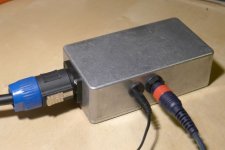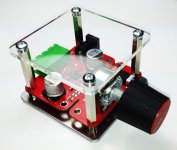I can't comment on the differences, but according to the SMSL website, this is what the new "upgrade version" should look like -
Yes, that is the board that is in mine. This is strange. The pic in my OP is showing up on both Ebay and Amazon for a "SMSL SA-36A Pro 2* 20W TPA3118D2DAP"
This is one such listing...
New SMSL SA 36A Pro 2 20W TPA3118D2DAP Amp Stereo Digital Amplifier 12V Power | eBay
3118 has no heatsink, this pic is tripath 2020 I guess
OK...it appears some pics have been mixed up. I think you are right. There is a listing on Amazon for their TA2020 amp that shows the pic of the TPA3118 board...LOL. I also found an ebay listing for the SMSL TA2020 amp that looks like the board in my OP. Thanks for helping me clear this up.
I recently bought this board, when it arrives I will post pictures of it and describe my experience with it.

Said -by the seller- to be a TPA3116 with better-quality parts on it in places where such make sense. We'll see.
I hope this works out. I have been thinking about trying this board for my first amp build but was waiting for some feedback on it that i could hopefully learn from.
matt_garman sent me his Edcor TTPC15k/15k matching transformer module to try out.
https://www.edcorusa.com/ttpc15k-15k
Currently, my CineMag-modified YJ TPA3116 blue/black amp is on loan to a friend who bought a modified YJ TPA3116 blue/black amp from me. His amp is identical to my CineMag-modified unit with the exception that his amp has the stock blue film box-type caps. No surprise that the transformer-modified unit sound far superior to the other unit.
Back to Matt's Edcor transformers, I decided to install the TTPC15k/15k module in my OSCON-modified Sure Electronics TPA3116 amp. I had to delicately solder in the transformer leads to the tiny SMD pads on the Sure amp board. The photo of the amp without the heat sink installed was taken before I realized the pin-out for this module is slightly different from the individual PC15k/15k transformers. The photo next to it shows the corrected connections.
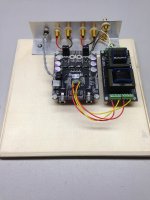
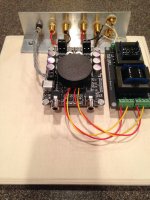
After a couple hours, the sound really settled in, and I was very impressed with the improvements in sound quality that these modestly-priced transformers made to the Sure amp. Just as I heard with the CineMags, the soundstage became larger and the imaging was a lot more focused. The noise floor really dropped and there was absolutely no hum as I've heard with the Sure amp before. The amp sounds smoother with a richer midrange and detailed treble. Bass is deep. I'd like it a bit tighter though. I've been spinning vinyl in my system listening to this amp, and I've been enjoying it since the weekend.
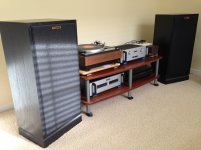
One huge improvement is the absence of the turn-on/turn-off pop. On turn-off, there is a faint click, but nothing as scary as what I heard before.
Once I get my CineMag-modified YJ amp back, I'll try these Edcors with that amp for a direct comparison to the CineMags. I would say that my preference is still with the CineMag-modded YJ amp versus the Edcor-modified Sure amp, but more critical listening needs to be done.
Thank you Matt for loaning these transformers for this experimentation!
https://www.edcorusa.com/ttpc15k-15k
Currently, my CineMag-modified YJ TPA3116 blue/black amp is on loan to a friend who bought a modified YJ TPA3116 blue/black amp from me. His amp is identical to my CineMag-modified unit with the exception that his amp has the stock blue film box-type caps. No surprise that the transformer-modified unit sound far superior to the other unit.
Back to Matt's Edcor transformers, I decided to install the TTPC15k/15k module in my OSCON-modified Sure Electronics TPA3116 amp. I had to delicately solder in the transformer leads to the tiny SMD pads on the Sure amp board. The photo of the amp without the heat sink installed was taken before I realized the pin-out for this module is slightly different from the individual PC15k/15k transformers. The photo next to it shows the corrected connections.


After a couple hours, the sound really settled in, and I was very impressed with the improvements in sound quality that these modestly-priced transformers made to the Sure amp. Just as I heard with the CineMags, the soundstage became larger and the imaging was a lot more focused. The noise floor really dropped and there was absolutely no hum as I've heard with the Sure amp before. The amp sounds smoother with a richer midrange and detailed treble. Bass is deep. I'd like it a bit tighter though. I've been spinning vinyl in my system listening to this amp, and I've been enjoying it since the weekend.

One huge improvement is the absence of the turn-on/turn-off pop. On turn-off, there is a faint click, but nothing as scary as what I heard before.
Once I get my CineMag-modified YJ amp back, I'll try these Edcors with that amp for a direct comparison to the CineMags. I would say that my preference is still with the CineMag-modded YJ amp versus the Edcor-modified Sure amp, but more critical listening needs to be done.
Thank you Matt for loaning these transformers for this experimentation!
Last edited:
One huge improvement is the absence of the turn-on/turn-off pop. On turn-off, there is a faint click, but nothing as scary as what I heard before.
That is for me the biggest benefit. I only tried those Edcors with the very first tpa3116 I ever worked on (a YJBlue). It's a messy affair, but it never suffered from the turn on/off popping. At the time, I didn't have the courage to hack on SMT components to try with a board that did exhibit bad turn on/off thumping (Ybdz/Weiner and Sure). But thanks to the DUG board, I now have a little SMT confidence!
Once I get my CineMag-modified YJ amp back, I'll try these Edcors with that amp for a direct comparison to the CineMags. I would say that my preference is still with the CineMag-modded YJ amp versus the Edcor-modified Sure amp, but more critical listening needs to be done.
Definitely eager to hear what you think of this. Based on what you've said so far, I think it's pretty safe to conclude they are already a high-value product. Fixing the turn on/off thump without having to resort to a manual toggle switch (as I've done) or some fancier relay or transistor based scheme I think is a huge win, and any sonic benefits are certainly icing on the cake.
Thank you Matt for loaning these transformers for this experimentation!
Thank you Rich for taking the time to experiment with these transformers and report your findings!
I would think 3VDC on iron core transformer would be far worse than previous original situation, but you may like the sound better.
Hi irribeo,
I've done this mod but i'm not certain of the impact, it seems to have add a kind of strange sybillance.
So I'm planning to solder two caps across the speakers terminals : Wima FKP-2 5mm 1.5nF or 1.0 nF.
How did you get the values of this caps, have you got the schematics of the Sure TPA3116 board ?
I've asked the support at Sure but no reponse after two days.
1nF but just remove them and leave open
I've done this mod but i'm not certain of the impact, it seems to have add a kind of strange sybillance.
So I'm planning to solder two caps across the speakers terminals : Wima FKP-2 5mm 1.5nF or 1.0 nF.
How did you get the values of this caps, have you got the schematics of the Sure TPA3116 board ?
I've asked the support at Sure but no reponse after two days.
Hi irribeo,
I've done this mod but i'm not certain of the impact, it seems to have add a kind of strange sybillance.
So I'm planning to solder two caps across the speakers terminals : Wima FKP-2 5mm 1.5nF or 1.0 nF.
How did you get the values of this caps, have you got the schematics of the Sure TPA3116 board ?
I've asked the support at Sure but no reponse after two days.
measured
yes Sure has found an addition to filter for BD modulation that all big names missed, after carefull testing for many months Sure decided this addition sounded best, together with connecting speakers out of phase ..or maybe they didn't intend any of it, didn't even know AD/BD filtering, just take your pick
hello, very late to this party. just glad it's still underway.
this thread was what drew me in to register. I couldn't see the pictures! ^_^. Anyway, was about to buy an SMSL SA-60 but seems Paypal does not ship to my country. (no diy experience) so it was a forced decision to purchase the board from aliexpress. Hoping that by the time (30 days) they arrive, I will have learned enough to put it together.
this thread was what drew me in to register. I couldn't see the pictures! ^_^. Anyway, was about to buy an SMSL SA-60 but seems Paypal does not ship to my country. (no diy experience) so it was a forced decision to purchase the board from aliexpress. Hoping that by the time (30 days) they arrive, I will have learned enough to put it together.
please post a pic when have managed the sockets.
i imagine that wiring is not easy in that little space.
Sorry for the delay. The Danz board fits in a 125B enclosure, but only just. Lined the base with teflon and shaved two unused corners off the pcb so it fits in the base. I've made two boxes; one stereo and one PBTL with a Speakon socket. 🙂
Attachments
Well, have it the small way. 🙂
http://www.diyaudio.com/forums/class-d/87913-class-d-amp-photo-gallery-94.html#post4179209
http://www.diyaudio.com/forums/class-d/87913-class-d-amp-photo-gallery-94.html#post4179209
Attachments
Edit: ughh, missed doctormord's reply. That's seriously small! No output filter?
Really happy with the two amps running 2.1. Nice and clean from 0 to way too loud for my room 🙂
Really happy with the two amps running 2.1. Nice and clean from 0 to way too loud for my room 🙂
Last edited:
Actually running without any filter, but 1206 ferrite-beads can be soldered into place. So there's just 200n boottraps with 300p+10R snubber and 1n to GND at the output. Runs fine (400-1000kHz)
How does the tpa3116 compare to the not so popular max9709?
Do you hear differences between the two amps?
Do you hear differences between the two amps?
Thanks for asking,
i could only speak of the two layouts i made (MAX9709, TPA3132D2), so from the first test runs, the TPA3132 is a bit less noisy, but i have to say that the MAX9709 is already really low noise. When the MAX9709 is low noise, the TPA3132 is "no noise" - which means, you wont hear any hiss from the tweeters if you're away from the tweeters with your ears more than like 5cms (2"). I also tested both with Beyma 8AG/N (96dB Fullrange), same result, you wont hear anything.
Soundwise, the MAX9709 is a bit more powerful at the bass, but this is only subjective. (But almost everyone who listened to a MAX9709 said that it has "warm" deep bass)
For the rest, the sound changes a bit with the selected gain, where the amps are designed for +26dB gain and a lower cutoff-frequency of 10-15Hz (-3dB). All in all its balanced and nice to the ears.
As i actually believe in proper system design and measurements, there is some more information for the MAX9709 here:
MAX9708 / MAX9709 25W / 50W Class-D - Messungen - #360customs
Both amps perform solid, with actually one disadvantage at the TPA3132D2 side - it is running alot hotter than the MAX9709. (Due to smaller qfn package and a non ideal GND-pinout)
At VCC=23V the ICs surface temp is:
TPA3132D2: 69.8°C
MAX9709: 40.2°C
Measured with shorted inputs and no load connected after 10 minutes. The TPA should perform better (thermal wise) due to lower Ron (120mR vs. 300mR) at the output-stage but suffers from smaller qfn-package and so higher Rth-JA.
This leads to the calculation of:
MAX9709:
TA = 30°C
Pout = 50W
Efficiency: 👎 = 86%
Rth_JA = 21K/W
Pdiss = (Pout / n) - Pout = (50W / 0.86) - 50W = 8.14W
TC = TA + Pdiss * Rth_JA = 30°C + 8.14W * 21K/W = 201 °C
Won't work!
Lets see, whats our max cont. output power:
Pout(TC)=[n*(TC-TA)] / [Rth_JA - Rth_JA*n]
For TC = 120°C
Pout(120°C) = [0.86*(120°C-30°C)] / [21K/W - 21K/W*0.86] = 26.32W
Pdiss(120°C) = (26.32W / 0.86) - 26.32W = 4.3W
The TPA3132D2 has Rth_JA 31.3K/W, with nearly the same efficiency:
Pout(120°C) = [0.88*(120°C-30°C)] / [31K/W - 31K/W*0.88] = 21.3W
Lets assume 94% efficiency (as in the datasheet:
Pout(120°C) = [0.94*(120°C-30°C)] / [31K/W - 31K/W*0.94] = 45.5W
Theoretically, the TPA will do more power, even in the smaller package, but this calculation is for 76x114mm pcb size, so cont. output power is way lower. On smaller pcbs the MAX9709 is in the lead because of his better RthJA (21K/w vs. 31K/W).
Conclusion:
The MAX9709 will perform better on limited PCB space (thermal wise) with less components. (no snubber nor bootstrap)
I hope this helps you out.
i could only speak of the two layouts i made (MAX9709, TPA3132D2), so from the first test runs, the TPA3132 is a bit less noisy, but i have to say that the MAX9709 is already really low noise. When the MAX9709 is low noise, the TPA3132 is "no noise" - which means, you wont hear any hiss from the tweeters if you're away from the tweeters with your ears more than like 5cms (2"). I also tested both with Beyma 8AG/N (96dB Fullrange), same result, you wont hear anything.
Soundwise, the MAX9709 is a bit more powerful at the bass, but this is only subjective. (But almost everyone who listened to a MAX9709 said that it has "warm" deep bass)
For the rest, the sound changes a bit with the selected gain, where the amps are designed for +26dB gain and a lower cutoff-frequency of 10-15Hz (-3dB). All in all its balanced and nice to the ears.
As i actually believe in proper system design and measurements, there is some more information for the MAX9709 here:
MAX9708 / MAX9709 25W / 50W Class-D - Messungen - #360customs
Both amps perform solid, with actually one disadvantage at the TPA3132D2 side - it is running alot hotter than the MAX9709. (Due to smaller qfn package and a non ideal GND-pinout)
At VCC=23V the ICs surface temp is:
TPA3132D2: 69.8°C
MAX9709: 40.2°C
Measured with shorted inputs and no load connected after 10 minutes. The TPA should perform better (thermal wise) due to lower Ron (120mR vs. 300mR) at the output-stage but suffers from smaller qfn-package and so higher Rth-JA.
This leads to the calculation of:
MAX9709:
TA = 30°C
Pout = 50W
Efficiency: 👎 = 86%
Rth_JA = 21K/W
Pdiss = (Pout / n) - Pout = (50W / 0.86) - 50W = 8.14W
TC = TA + Pdiss * Rth_JA = 30°C + 8.14W * 21K/W = 201 °C
Won't work!
Lets see, whats our max cont. output power:
Pout(TC)=[n*(TC-TA)] / [Rth_JA - Rth_JA*n]
For TC = 120°C
Pout(120°C) = [0.86*(120°C-30°C)] / [21K/W - 21K/W*0.86] = 26.32W
Pdiss(120°C) = (26.32W / 0.86) - 26.32W = 4.3W
The TPA3132D2 has Rth_JA 31.3K/W, with nearly the same efficiency:
Pout(120°C) = [0.88*(120°C-30°C)] / [31K/W - 31K/W*0.88] = 21.3W
Lets assume 94% efficiency (as in the datasheet:
Pout(120°C) = [0.94*(120°C-30°C)] / [31K/W - 31K/W*0.94] = 45.5W
Theoretically, the TPA will do more power, even in the smaller package, but this calculation is for 76x114mm pcb size, so cont. output power is way lower. On smaller pcbs the MAX9709 is in the lead because of his better RthJA (21K/w vs. 31K/W).
Conclusion:
The MAX9709 will perform better on limited PCB space (thermal wise) with less components. (no snubber nor bootstrap)
I hope this helps you out.
Thanks for asking,
Soundwise, the MAX9709 is a bit more powerful at the bass, but this is only subjective. (But almost everyone who listened to a MAX9709 said that it has "warm" deep bass)
I hope this helps you out.
MAX9709 does have a rising deep bass frequency respons ?? Do I read that correctly from measurements ?? Seems MAX9709 has deep bass that is boosted and you mean undetailed/warm ??
Theres's absolutely no "boost functionallity" build into the IC. 😵
There's even is no measurement which points at something like this. (What measurement do you mean?)
I don't mean "undetailed", it's more like "rich" and pleasuring, a bit like tube sound due to harmonic distortion.
(Something like expected from a tube buffer)
But as i said, this is subjective, as the measurements show nothing like that and you always "hear" what you're "expecting".
Measured frequency responce is:

10Hz - 22kHz +-0.5dB, which is considered to be "flat".
There's even is no measurement which points at something like this. (What measurement do you mean?)
I don't mean "undetailed", it's more like "rich" and pleasuring, a bit like tube sound due to harmonic distortion.
(Something like expected from a tube buffer)
But as i said, this is subjective, as the measurements show nothing like that and you always "hear" what you're "expecting".
Measured frequency responce is:

10Hz - 22kHz +-0.5dB, which is considered to be "flat".
Last edited:
I also have TDA7297 and like it. Any comments on comparison of amps u own?
It's a better amp, but... To get it to be better takes a lot of ground work and playing around. I've been working on it for months. It's not what people think, not really. First off it has balanced outputs.
- Home
- Amplifiers
- Class D
- TPA3116D2 Amp
